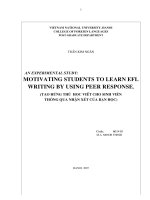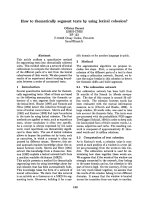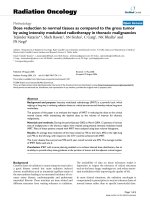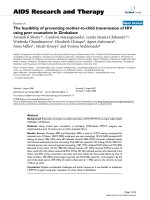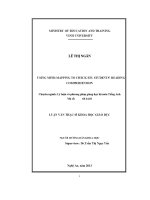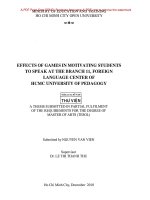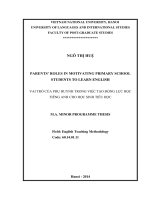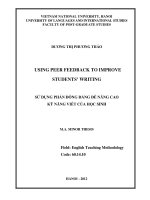MOTIVATING STUDENTS TO LEARN EFL WRITING BY USING PEER RESPONSE
Bạn đang xem bản rút gọn của tài liệu. Xem và tải ngay bản đầy đủ của tài liệu tại đây (558.24 KB, 65 trang )
1
VIETNAM NATIONAL UNIVERSITY, HANOI
COLLEGE OF FOREIGN LANGUAGES
POST-GRADUATE DEPARTMENT
TRầN KIM NGÂN
AN EXPERIMENTAL STUDY:
MOTIVATING STUDENTS TO LEARN EFL
WRITING BY USING PEER RESPONSE.
(T¹O HứNG THú HọC VIếT CHO SINH VIÊN
THÔNG QUA NHậN XéT CđA B¹N HäC)
Code:
601410
M.A. MINOR THESIS
HANOI 2007
2
3
VIETNAM NATIONAL UNIVERSITY, HANOI
COLLEGE OF FOREIGN LANGUAGES
POST-GRADUATE DEPARTMENT
TRầN KIM NGÂN
AN EXPERIMENTAL STUDY:
MOTIVATING STUDENTS TO LEARN EFL
WRITING BY USING PEER RESPONSE
(T¹O HứNG THú CHO SINH VIÊN HọC VIếT
THÔNG QUA NHậN XéT CủA BạN HọC)
Field:
Code:
Course:
English Methodology
601410
K13
M.A. MINOR THESIS
Supervisor: Dr. Trần Xuân Điệp
HANOI 2007
4
ABSTRACT
Looking at the teaching and learning English at the present it is found that there is a
necessity to vary the methods of teaching as well as improve the teaching and learning condition
so that the standard in studying foreign languages in general and English in particular can be
higher and higher.
Further more, due to the application of communicative language teaching method (CLT), it
is clear that students should be well-motivated and activated in learning a foreign language.
Therefore, in learning writing, it is suggested that activities which have been neglected now
should be taken into consideration since it is believed to make the lesson more motivating.
There is no doubt that writing provides students chances to express themselves correctly
and communicatively. But the standard of writing of Vietnamese students is of low qualification
due to the fact that both teachers and students are not very keen on writing practice since almost
English tests focus on grammar and reading comprehension in stead of writing skill.
In order to motivate learners to write as well as improve their writing skill, this study aims
to investigate peer response method in teaching students’ EFL writing. Subjects for the study are
56 second-year students from English department of Hanoi University of Education divided into
two groups, control and experiment groups. An experiment on the use of peer response approach
to writing is designed and conducted for 16 weeks of the second semester of 2006-2007 school
year. The outcomes show that (1) the new method improves students’ writing skill; (2) it has
positive effects on students’ attitude and motivation. Other results from data collected will
provide teachers information on the technique for implementing peer response approach in
teaching writing.
5
ACKNOWLEDGEMENTS
I certify that this minor thesis entitled “Using peer response to motivate students’ learning
EFL writing” is submitted in partial fulfillment of the requirements for the degree of Master of
Arts is the results of my own work, except where otherwise acknowledge and that this minor
thesis or any part of the same has not been submitted for a higher degree to any other university
or institution.
To complete my thesis, I have received generous advice and assistance from many lecturers
in the Post Graduate Department of College of Foreign Languages, Hanoi National University
whose lectures are very practical and useful.
First and foremost, my deepest gratefulness is due to Dr. Tran Xuan Diep, my supervisor,
for his valuable advice, close guidance, constructive criticism and continual encouragement
from the preparation to completion of this M.A. thesis. Without his help, this study could not
have possibly been accomplished.
My earnest appreciation goes to teachers and second-year English major students at HUE
for their enthusiastic cooperation during my experimental research.
Last but not least, I would like to express my heartfelt gratitude to my dear family and
friends who have constantly supported and inspired me during the time I carried out this study.
6
TABLE OF CONTENTS
Abstract
Acknowledgements
Definition of terms
List of abbreviation
List of tables, figures and appendices
CHAPTER ONE: INTRODUCTION
I.
II.
III.
IV.
V.
VI.
Identification of the problem
Purpose of the research
Significance of the research
Scope of the research
Research methods
Content of the Study
CHAPTER TWO: THEORETICAL BACKGROUND
I. Overview of writing
1. General concept
2. Teaching English writing
2.1. Written versus spoken language
2.2. Approaches in teaching English writing
2.3. Microskills of writing
2.4. Writing activities
II. Overview of peer response
1. Definition
2. Advantages of peer response
3. Guiding principles for effective peer response
III. Overview of motivation
1. Definition and types of motivation
2. Characteristics of motivated learners
3. Strategies to boost students’ motivation
4. Roles of motivation in foreign language learning
CHAPTER THREE: METHOD AND PROCEDURES
I. Determining on the research hypothesis
II. Determining on the study design
1
2
2
3
3
3
5
5
5
5
5
6
9
10
11
11
11
12
13
13
15
15
16
17
17
18
7
III. Participants
1. The Subjects
2. The Researcher
IV. Data collection procedures
1. Data collection instruments
1.1. Questionnaires
1.2. Pre- and post-experimental test
2. Data collection procedures
2.1. Before experiment period
2.2. During experiment period
2.3. After experiment period
19
19
20
20
20
20
21
22
22
23
25
26
CHAPTER FOUR: PRESENTATION AND ANALYSIS OF DATA
26
I. Analysis of questionnaires
26
1. Students’ general information
2. Students’ attitudes towards peer response method
29
3. Comparison of students’ attitudes before and after the
experiment
30
33
4. Students’ opinions after peer response treatment
34
II. Analysis of tests
34
1. Analysis of pre-test
34
1.1. Frequency distribution
35
1.2. Measures of central tendency
36
1.3. Measures of dispersion
37
2. Analysis of post-test
37
2.1. Frequency distribution
37
2.2. Measures of central tendency
38
2.3. Measures of dispersion
39
2.4. T-test for independent means
42
CHAPTER FIVE: CONCLUSION
42
1. Summary and discussion
43
2. Recommendations
45
3. Limitations
45
4. Suggestions for further studies
References
Appendices
8
Definition of terms
-
-
-
-
Central tendency: The tendency of a set of scores to cluster around a particular value. The
usual measures of central tendency are the mean, median, and the mode.
Control group: The group under normal situation (with traditional teaching/learning
approach).
Dispersion: The tendency for a set of scores to spread out or depart from the average or
‘typical’ values in the set of scores. Dispersion is usually measured through the range, the
mean deviation, the variance, and the standard deviation of the scores.
Experiment group: The group under experimental conditions (with innovative
teaching/learning approach).
Experiment: A procedure for testing a hypothesis by setting up a situation in which the
strength of the relationship between variables can be tested. In an experiment, the
researcher’s goal is to establish a cause-and-effect relationship between two phenomena.
The researcher aims to establish that one variable, the independent variable, causes changes
in another variable, the dependent variable.
- A true experiment consists of control and experiment groups to which subjects
have been randomly assigned and tested before and after the intervention
administered to the experiment group.
- A quasi-experiment has both pre- and posttest, and experiment and control
groups, gut no random assignment of subjects.
Hypothesis: A formal statement about an expected relationship between two or more variables
which can be tested through an experiment.
Interview: The elicitation of data by one person from another through person-to-person
encounters.
Mean (Symbolized by X):
- The average of a set of scores, obtained by adding the scores together and dividing
by the total number of scores.
- The central tendency of the scores.
Mode: The value which occurs most frequently in a set of scores.
Median: The middle point in a distribution.
Population: All cases, situations, or individuals who share one or more characteristics.
- Qualitative data: Data which are recorded in non-numerical form, such as transcripts of
classroom interactions.
- Quantitative data: Data which are recorded in numerical form.
- Questionnaire: An instrument for the collection of data, usually in written form, consisting of
open and/or closed questions and other probes requesting a response from subjects.
- Range: Difference between the highest and lowest values in a set of scores.
- Raw score: The actual scores obtained on tests.
- Sample: A subset of individuals or cases from within a population.
9
- Standard deviation (SD): is the degree to which the group of the scores deviates from the
mean. The standard deviation is a very powerful measure of ‘dispersion’. Large SD shows:
(a) the score distribution is wide; (b) the test has spread the students out; (c) there is a wide
range of ability.
- T-test: A statistic procedure for testing the difference between two or more means. The t test
for independent means is used for differences between means of two groups. The paired t
test or the t test for correlated data is used for differences between means of the same group
(that is, the experimental group) at two different points in time.
- Variable: A property or characteristic which may differ from individual to individual or from
group to group (anything which does not remain constant). A great deal of research is
carried out in order to identify or test the strength of relationships between variables. When
one variable influences or affects a second variable, the first variable is called an
independent variable, and the second is called a dependent variable.
- Variance: The variance is a direct measure of the dispersion , calculated for a set of scores by
subtracting each score from the mean, squaring the resulting values, adding these together,
and dividing by the remainder of the number of the scores minus 1.
10
List of Abbreviation
C
control
D
deviation
E
experiment
EFL
English as a foreign language
f
frequency with which a score occurs
H
hypothesis
H0
null hypothesis
= XE - XC = 0
H1
positive hypothesis
= XE - XC > 0
Hanoi University of Education
HUE
N
p
SD
tobs
tcrit
number of scores
probability
standard deviation
observed statistic
critical statistic
raw score
X
the mean
X
the mean of experiment group
XE
the mean of control group
XC
the total amount (the sum)
Σ
11
List of tables
Page
Table 1: Comparing spoken language & written language
6
Table 2: Approaches to teaching writing skill
7
Table 3: Criteria for testing writing
10
Table 4: The number of students in the two groups
19
Table 5: Procedures of data collection
22
Table 6: Scoring scale for writing test
23
Table 7: Results of questionnaire A
29
Table 8: Results of questionnaire B, part I
30
Table 9: Results of questionnaire B, part II
33
Table 10: Comparison of pre-test performances of the two groups
35
Table 11: Comparison of post-test performances of the two groups
38
List of figures
12
Figure 1: Gender of the control and experimental groups
19
Figure 2: Students’ experiences of studying English
27
Figure 3: Students’ attitudes to the English language learning
27
Figure 4: The necessity of studying writing
28
Figure 5: Students’ expectation on the usefulness of the writing course
28
Figure 6: “Peer response stimulates students’ creativeness and activeness”
30
Figure 7: “It’s interesting and useful to read and give comment on others’ writings.”
31
Figure 8: “Giving peer response helps to develop critical reading skill”
31
Figure 9: “Peer response activities help learners to enhance communicative competence, 32
promotes second language development”
Figure 10: “Peer response increases negotiation of meaning so as to generate more 32
information for content and rhetorical issues”
Figure 11: “Peer response provides chances to build strong classmate relationship and 33
gives students a sense of group cohesion”
Figure 12: Pre-test score distribution
34
Figure 13: Post-test score distribution
37
List of appendices
Appendix 1: Questionnaire A
Appendix 2: Questionnaire B
Appendix 3: Criteria for effective questioning
Appendix 4: Common topics for students to practice writing
Appendix 5: Grading rubric for writing test
CHAPTER ONE
13
INTRODUCTION
I.
IDENTIFICATION OF THE PROBLEM
English has experienced its popularity in teaching and learning in Vietnam over the last
decades. It is taught in almost all educational institutions: universities, colleges, training centers,
etc. The demand for learning English even gets stronger when Vietnam fosters its international
relations. English, in parallel with the knowledge of some other fields, turns out to be a key to
open the door into the bustling world. As a result, learning English now is not only an interest
but also a practical need for many people.
This demand in language learning has brought about a great amount of positive changes in
language teaching in Vietnam. Language teachers have looked for and tried different methods
and techniques in teaching and learning in order to find the effective ones. The effectiveness of
a teaching method or technique is reflected in the learners’ language competence that is their
abilities to perform the four language skills: listening, speaking, reading, writing, among which,
writing seems to be the most difficult one. It is the fact that the question of teaching writing well
and effectively has been the concern of many people.
Being a teacher of English at HUE, I realize that most of the students face many problems
in learning writing. This is due to the fact that writing lessons are so boring that students often
feel tired and stressed. Therefore, it is essential for the teacher to find out effective teaching
approaches to make the lessons more interesting so that s/he can attract students’ attention and
help improve their writing proficiency as well.
Traditionally, students are the passive knowledge receivers who have to do what their
teachers ask them to do. There is a fact that in most language classes, especially large classes,
most learners only passively sit and take notes , rarely contribute in the lesson and even do not
ask the teacher questions when they have problems. But we all know that students’ interaction
and their autonomy in learning foreign languages play an important part in the success of
teaching and learning process. That means teachers cannot teach effectively without students’
participation. In light of communication approach in language teaching which emerges as the
latest development, we are now paying more attention to the role of students in classes. Student
are considered the centre of the learning process and teachers serve as facilitators allowing
students to be in charge of their own learning.
14
With active, independent participation from one another, peer response is considered as
learner-center approach with which students can assess one another’s task to help correct and
improve language skills under the supervision from teachers. This is especially helpful if we
have mixed ability group where weaker students can learn a lot from stronger ones. Peer work is
a valuable addition to a variety of learning activities which encourages and promotes foreign
language skill development.
Although peer response is important in effective language teaching, there is inadequate
research on this issue. As far as this matter is concerned, there has been almost no research
work touching upon the issue of motivating students’ writing skill through peer activities. For
this reasons, I decided on choosing “Using peer response to motivate students’ writing skill” as
topic of my M.A. research.
II. PURPOSE OF THE RESEARCH
The major purposes of the research are:
1. This research, based on an experiment, tries to explore the effect of peer response method on
students’ writing motivation and proficiency.
2. To find students’ attitudes towards peer response
3. To suggest implications for teachers in order to raise their awareness of students’ active role
in writing lessons.
In order to implement the research, a research question is raised: “To what extent does the
method of peer response help to motivate students’ writing?”
III.
SIGNIFICANCE OF THE RESEARCH
The results of the study will bring in practical benefits to teaching English, especially
teaching writing. If peer response method helps motivate students’ writing skills, it will be
applied at different scales. At small scales, the study provides practical lessons and principles of
peer response as one of the innovative methods available for the choices of language teachers at
HUE. At larger scales, the writing materials might be revised to incorporate the peer response
method into the present writing program.
15
IV.
SCOPE OF THE RESEARCH
The study is concerned with finding the effects of using peer response approach in
motivating students to learn EFL writing for the students at HUE in comparison with the
traditional one (teachers’ response only). Other approaches to teaching writing intended for
students would be beyond the scope.
V.
RESEARCH METHODS
In order to achieve the above mentioned aims to make the study more practical, data were
collected by means of tests and questionnaires and analysis is also used to process the materials.
The primary data analysis is of quantitative method with close questions and scale questions in
the questionnaire designed for the needs analysis, and students’ attitude analysis.
A need analysis was conducted among the existing students of English major in order to
find out whether the students at HUE consider learning writing useful and find out their
attitudes to peer response approach. Lastly, statistic analysis of students’ test scores is used to
identify any improvement made by the students in writing after the experiment. The analysis
also helps find out the strengths and drawbacks of peer response, which may result in
appropriate adjustments in the teaching method of the instructor.
The books, articles and internet sources on peer response method for teaching writing are
collected to examine the history of the fields and available suggestions in the practice of
teaching writing.
VI.
CONTENTS OF THE STUDY
The study comprises four chapters:
-
Chapter one is the introduction stating the problem identification, objectives,
significance and research method. It also narrows the scope of the study and
briefly presents an overall out-line of the research study.
-
Chapter two reviews the theoretical background of the study. It presents
overview of teaching writing, peer response and motivation in foreign language
teaching.
16
-
Chapter three describes in details the research methodology which comprises the
information of the research subjects, instruments for data collection and
procedure for data collection.
-
Chapter four presents statistical results and the analysis of the collected data. The
statistical results are the basement to determine the effects of peer response
method on teaching writing.
-
Chapter five is the conclusion which closes the study by summarizing the main
contents and providing suggestions for further study.
17
CHAPTER TWO
THEORETICAL BACKGROUND
This chapter consists of three sections. Section one deals with general ideas about writing.
Section two mentions some concepts related to the activity of peer response in writing and
guiding principles for effective peer response. The last section deals with motivation in
language learning.
OVERVIEW OF WRITING
I.
1. General concept
In language teaching, writing is defined as a productive and taught language skill.
According to Ur (1996) “most people acquire the spoken language (at least their own mother
tongue) intuitively, whereas the written form is in most cases deliberately taught and learned”
(p.161). He added that “writing normally requires some form of instruction. It is not a skill that
is readily picked up by exposure” (p11).
In short, the word “writing” itself may imply an act, a process or a skill, which needs
practice and study to develop. It requires both physical and mental powers from the writers.
2. Teaching English writing
In this part of the study, what have been previously published about the teaching
methodology of English writing will be examined. First a distinction between the characteristics
of written and spoken texts will be presented. Secondly, traditional and modern approaches in
teaching writing will be discussed. Lastly, the study will provide microskills in writing and
tasks and activities in writing classes.
2.1.
Written versus spoken language
Brown & Yule (1983) propose that information is packed very much more densely in the
written language than in the spoken form with a more complicated set of vocabulary and
grammar rules. It is generally believed that the nature of written language will be most clearly
seen when being contrasted with that of the spoken language. Written language is formal and
stable while spoken language is informal and variable. Therefore, it appears much easier to
provide a model of written language than of spoken one.
18
Ur (1996: 159-161) suggests nine characteristics that distinguish written from spoken
language. His analysis is summarized in Table 1:
Written language
permanent
explicit
dense
detached in time and
Permanence
Explicitness
Density
Detachment
Spoken language
fleeting and movable
assumed, implicit
include repetitions, glosses, fillers
takes place with intermediate interaction
place from readership
Organization
well organized, edited
Slowness of production, slower to produce, but
and feedback
improvising
quicker to produce but listening speed
speed of reception
quicker to read
Standard language
standard
is decided by the speed of speaker
may be in regional, or limited-context
A learnt skill
Sheer amount and
must be taught and learnt
used less
importance
(Source: Adapted from Ur, 1996: 159-161)
dialect
mother tongue is acquired
used more in life
Table 1: Comparing Spoken language and Written language.
According to the data, the different features between spoken and written language suggest
some cautions in teaching writing. Because written texts are permanent and can be referred
many times, they must be written with careful choice of vocabulary and structures.
2.2.
Approaches in teaching English writing
There are various ways to teach writing but the two most common are the product approach
and the process approach. Nunan (1991) introduced the two approaches in teaching writing and
the differences between them clearly as follows:
a. The product approach
- In favour of classroom activities in which
-
b. The process approach
Favour of collaborative group work and
the learners individually imitate copy and
conferencing to enhance motivation and
transform model of correct language,
positive attitude toward writing. Model
usually at sentence level.
texts are only for comparison.
- Organization of ideas is more important
than ideas themselves.
- Emphasize grammar exercises and
correctness.
-
Ideas are important.
-
The learners are encouraged to get their
ideas on paper without worrying too much
about correctness.
19
- Focus on the end result of the writing
-
process: the writing paper of the learners.
Focus on the various forms of classroom
activities which promote the development
of language use.
- Learners only produce one final draft.
-
The final draft is the result of a long and
painful process of writing successive drafts
Table 2: Approaches to teaching writing skill
a. The Product Approach
To be more specific, the product approach concentrates on the end product that writer has
to produce. Teachers following the product approach often begin the lessons with presenting a
model text, which is then analyzed on the purpose, language, the organization, and the style.
The aim is to enable the learners to produce similar texts. Learning is evaluated through text
analysis of learner’s work according to some criteria such as the standard of rhetorical style,
accurate grammar, and conventional organization (Brown 1994: 320).
The value of this
approach is the use of models for text analysis and as a basis for thinking about the purposes
and readership of a text
b. The Process Approach
Unlike the product approach, the process approach focuses on thinking and writing
processes. The product approach sees the language learners as creators of language, decision
makers of the message and content (Brown 1994: 320). It is argued by Nunan (1991: 87) that
while the product-oriented approach aims at developing the learner’s writing skill mainly at
sentence-level, the process-oriented approach aims at language at discourse-level.
In the view of Hedge (1990), the process contains a lot of stages which can be illustrated as
follows: “being motivated to write – getting ideas together – planning and outlining – making
notes – making a first draft – revising, replanning, redrafting – editing and getting ready for
publication.”. Meanwhile, according to Oshima and Hogue (1991), the writing process
embraces essentially three steps: pre-writing, planning (outlining), writing, and revising drafts.
Each step involves certain kinds of task that the writers have to fulfill in order to construct a
good piece of work.
* Pre-writing
Pre-writing is any classroom activity that encourages the learners to write. It stimulates thoughts
for getting started. It may include understanding the purpose of writing, discovering the topic,
thinking about the audience, gathering information or inventing possible content. Once the
20
possible content for writing has been explored, the writers will feel more confident to move
forward to the next stage.
* Planning
In this stage, the learners organize the ideas they have generated. The most efficient way to do
this is to make an outline - a plan in which the learners write down the main points and subpoints in the intended order.
* Drafting
Once sufficient ideas have been gathered and plan already drawn, the first attempt at writing –
drafting can proceed quickly. At this stage, the writers are focused on the fluency of writing and
are not preoccupied with grammatical accuracy or the neatness of the draft.
* Responding
Responding to student writing has a central role to play in the successful implementation of
process writing. It is a kind of oral or written intervention by teachers or peers or other possible
readers after the writers have finished drafting. This activity is intended to provide the students
useful information to improve their writing.
* Revising
Revising is done on the basis of the feedback given in the responding stage. The students
reexamine what was written to see how effectively they have communicated their meanings to
the readers. Revising is not just checking for language errors; it is done to improve the global
content and the organization of ideas so that the writer’s intention is made clearer to the readers.
* Editing
At editing stage, the students are engaged in tidying up their texts as they prepare the final draft
for evaluation by the teachers. Editing is vital as it is not done for its own sake but as a part of
the process of making communication as clear and unambiguous as possible to the reader.
* Evaluating
In evaluating the student writing, teachers normally assign scores which may be analytical
(based on specific aspects of writing ability), or holistic (based on a global interpretation of the
effectiveness of that writing). In order to be effective, the criteria for evaluation need to be
made known to the students in advance.
2.3. Microskills of writing
According to Brown (1994: 327), writing involves the microskills as presented in the list below:
1.
Produce graphemes and orthographic patterns of English
2.
Produce writing at an efficient rate of speed to suit the purpose.

